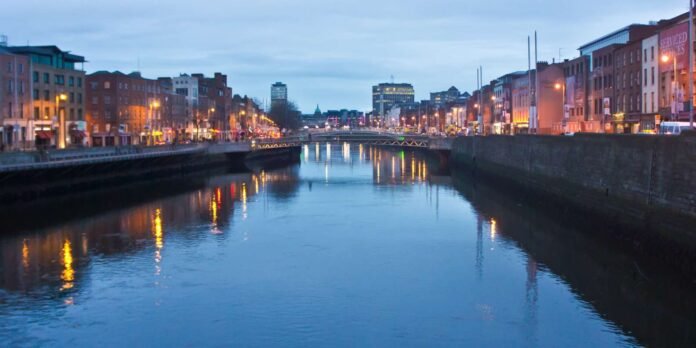Historical Significance of the River Liffey
The River Liffey, flowing through the heart of Dublin, has been a pivotal force in shaping the city’s history and development. Originating from the Wicklow Mountains, the river’s journey through Dublin has seen it become an essential artery for trade, commerce, and settlement since ancient times. During the Viking era, the River Liffey served as a strategic entry point, enabling the Norsemen to establish Dublin as a key maritime hub. The Vikings leveraged the river’s navigability to facilitate trade routes that reached across Europe, laying the foundation for Dublin’s growth.
As the centuries progressed, the Liffey’s role in trade and commerce only grew more significant. During medieval times, the riverbanks became bustling centers of activity, with merchants and traders converging to exchange goods. The construction of bridges, such as the iconic Ha’penny Bridge in 1816, exemplified the river’s centrality in the daily lives of Dubliners. This pedestrian bridge, so named for the half-penny toll originally required to cross, remains a symbol of Dublin’s rich history and enduring charm.
Another landmark, the Custom House, completed in 1791, stands as a testament to the River Liffey’s importance in Dublin’s commercial expansion. This neoclassical building served as the administrative center for customs and excise duties, further cementing the river’s role in economic activity. The presence of such landmarks along the Liffey underscores its influence on the city’s architectural and cultural landscape.
The river has also played a crucial part in Dublin’s urbanisation. Over the years, the banks of the Liffey have been developed to accommodate the growing population and the city’s expanding infrastructure. The river has acted as a natural boundary, guiding the layout and expansion of Dublin. Its waters have powered mills, provided a source of drinking water, and even contributed to the city’s sanitation efforts. Through its different roles, the River Liffey has indelibly shaped the historical and urban development of Dublin.
Modern-Day River Liffey: A Cultural Hub
The Liffey, which meanders through the heart of Dublin, today stands as a vibrant cultural hub, embedded in the social and cultural fabric of the city. Its banks host a plethora of festivals and events that draw both locals and tourists alike. One of the most iconic events is the St. Patrick’s Day Parade. This celebration sees the riverbanks thronged with spectators enjoying the colorful floats, lively music, and spirited performances that epitomise Irish culture.
Equally notable is the annual Liffey Swim, a tradition that has been upheld since 1920. This open-water swimming event attracts participants from all parts of the world, showcasing how Dublin brings people together. These events are just a glimpse into the role the River Liffey plays in Dublin’s contemporary scene.
Beyond festivals and events, the River Liffey offers a multitude of recreational activities that make it such a part of daily life in Dublin. River cruises provide a scenic and leisurely way to explore the city’s landmarks from a unique vantage point, while kayaking offers a more adventurous alternative for those looking to engage with the river on a deeper level. The well-maintained boardwalks along the riverbanks provide the perfect setting for a relaxing stroll, a brisk jog, or simply sitting and soaking in the views.
The River Liffey’s makes a big contribution to tourism and business. Its scenic beauty and the myriad of activities available along its banks make it a major attraction for visitors. Tourists can walk its boardwalks, partake in river cruises, and attend various cultural events, all of which contribute to Dublin’s reputation as a vibrant and welcoming city.
Environmental Concerns and Conservation Efforts
The river is a vital waterway flowing through Dublin. However, it faces a myriad of environmental challenges that threaten its health and biodiversity. Pollution, stemming from both industrial activities and urban runoff, pose risks to the river’s ecosystem.
In response to these environmental threats, various conservation projects and initiatives have been launched to safeguard the River Liffey. These efforts are spearheaded by organizations such as the Environmental Protection Agency (EPA) and the Dublin City Council, working in collaboration with local community groups. One notable initiative is the River Liffey Clean-Up Project, which mobilizes volunteers to remove litter and debris from the river. This project not only improves water quality but also raises public awareness about the importance of maintaining a clean and healthy river.
Another significant effort is the Liffey Valley Park Alliance, which advocates for the conservation of the river’s natural habitats and promotes sustainable land use practices. This alliance actively engages in habitat restoration projects, such as replanting native vegetation and creating buffer zones to mitigate the impacts of flooding. Moreover, the alliance collaborates with researchers to monitor the health of the river’s biodiversity, ensuring that conservation strategies are informed by scientific data.
Efforts contine to conserve the river. Recently in a major clean-up operation, over 10 tons of waste were removed from the river, significantly improving its condition. Additionally, efforts to reintroduce native species, such as the Atlantic salmon, have shown promising results, with a noticeable increase in their populations. These achievements underscore the importance of continued conservation efforts.
The river hosts a variety of fish and fauna. Key species include brown trout, which thrive in its cleaner waters upstream. The Atlantic salmon, notable for their migratory journey, has resided in the river though its numbers are extremely low now. Eels and pike also inhabit the river, contributing to its biodiversity. The Liffey’s banks support fauna, including birds like herons and kingfishers, which rely on the river for food. Aquatic plants, such as water crowfoot and pondweed, enhance the habitat, providing cover and nourishment for various aquatic organisms. Having said that the Liffey. like many major rivers flowing through citys across Europe and the world, continues to endure significant challenges.
Stories from the River Liffey
It has also been the heart of several noteworthy events in recent times. One significant story is the marking of the 200th anniversary of the Ha’penny Bridge, Dublin’s iconic pedestrian bridge spanning the Liffey. This milestone was celebrated with various cultural events and exhibitions highlighting the historical significance of the bridge and its role in connecting the city’s north and south sides.
In terms of infrastructure, the development of new flood defenses along the River Liffey has been a major project aimed at protecting Dublin from potential flooding. These measures, involving the construction of barriers and the enhancement of drainage systems, have been crucial in safeguarding both residential and commercial areas adjacent to the river. The project’s completion has been met with widespread approval from the community, emphasising the importance of proactive measures in urban planning.
The ongoing relationship between Dubliners and the River Liffey is a testament to the river’s enduring significance. It serves not only as a geographical landmark but also as a symbol of Dublin’s heritage and resilience. Whether through celebrations, infrastructural advancements, or community efforts to address environmental issues, the River Liffey continues to be an integral part of Dublin’s identity, reflecting the dynamic interplay between the natural environment and urban life.
Did you know there is also another river flowing through Dublin? You can check out the much lesser known River Poddle here.


